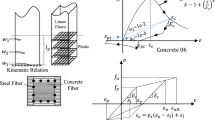Abstract
Corrosion of reinforcement reduces the load carrying capacity, energy dissipation and ductility of Reinforced Concrete (RC) members. In the present study, reinforcements of RC beam are subjected to 10, 25, and 30% corrosion and the respective RC beams are tested to evaluate their ultimate load behaviour. A huge drop in energy dissipation capacity of the RC beam is observed beyond the corrosion level of 10%. Further, nonlinear finite element analysis is employed to assess the load–displacement behaviour and ultimate load of RC beam. The corrosion induced damage to the reinforcement is represented in the finite element model by modifying its mechanical properties based on the results reported in the literature. The resultant load versus displacement curves of reinforced concrete beams are obtained. Good correlation is observed between the finite element analysis results and that obtained from experimental investigation on the control beam. The experimental results are also compared with the finite element analysis results for RC beams with corroded reinforcement. In order to understand the effect of corrosion on the mechanical properties of reinforcement, the corroded reinforcements are modelled in nonlinear finite element analysis by (i) reducing the area of reinforcement alone (ii) by reducing both area and mechanical properties and (iii) reducing the mechanical properties without reducing the area of steel as reported in literature. The results obtained for the beam with corroded reinforcement confirms reduction in yield stress and ultimate stress of the reinforcement steel.









Similar content being viewed by others
References
C.Y. Chao, L.F. Lin, D.D. MacDonald, A point defect model for anodic passive films I. Film Growth. J. Electrochem. Soc. 128, 1187–1194 (1981)
T.E. Pou, O.J. Murphy, V. Young, J.O.M. Bockris, L.L. Tongson, Investigation of the anodically formed passive film on iron by secondary ion mass spectroscopy. J. Electr. chem. Soc. 131, 2785–2790 (1984)
K. Bhargava, A.K. Ghosh, Y. Mori, S. Ramanujam, Models for corrosion-induced bond strength degradation in reinforced concrete. ACI Mater. J. 104, 594–603 (2007)
C.A. Apostolopoulos, V.G. Papadakis, Consequences of steel corrosion on the ductility properties of reinforcement bar. Constr. Build. Mater. 22, 2316–2324 (2008)
M. Maslehuddin, I.M. Allam, G.J. Al-Sulaimani, A.I. Al-Mana, S.N. Abduijauwad, Effect of rusting of reinforcing steel on its mechanical properties and bond with concrete. ACI Mater. J. 87, 496–502 (1990)
R. Palsson, M.S. Mirza, Mechanical response of corroded steel reinforcement of abandoned concrete bridge. ACI Struct. J. 99, 157–162 (2002)
J. Cairns, G.A. Plizzari, Y. Du, D.W. Law, C. Franzoni, Mechanical properties of corrosion reinforcement. ACI Mater. J. 102(4), 256–264 (2005)
Y.G. Du, L.A. Clark, A.H.C. Chan, Residual capacity of corroded reinforcing bars. Mag. Concr. Res. 57(3), 135–147 (2005)
S. Shin, I. Kang, S. Lee, H. Lee, J. Kyung, FEM analysis on the strength of RC members deteriorated by local part corrosion of tension main rebar, in Proceeding of the International Conference on Sustainable Buildings, Seoul, (2007), pp. 1161–1166
J. Xia, W.L. Jin, Y.X. Zhao, L.Y. Li, Mechanical performance of corroded steel bars in concrete. Proc. Inst. Civil Eng. Struct. Build. 166, 235–246 (2013)
A.R. Hawileh, A.J. Abdalla, A.A. Tamini, K. Abder lrahman, Behavior of corroded steel reinforcing bars under monotonic and cyclic loadings. Mech. Adv. Mater. Struct. 18(3), 218–224 (2013)
T. Potisuk, C.C. Higgins, T.H. Miller, S.C. Yim, Finite element analysis of reinforced concrete beams with corrosion subjected to shear. Adv. Civil Eng. Article ID 706803, 1–14 (2011)
S. Gopinath, A.R. Murthy, N.R. Iyer, Nonlinear finite element analysis of RC structures incorporating corrosion effects. Comput. Mater. Continua 22, 55–71 (2011)
K.J. Willam, E.D. Warnke, Constitutive model for the triaxial behavior of concrete, in Proceedings, International Association for Bridge and Structural Engineering, ISMES, Bergamo, Italy, vol. 19, (1975), p. 174
P. Desayi, S. Krishnan, Equation for the stress–strain curve of concrete. J. Am. Concr. Inst. 61, 345–350 (1964)
D. Coronelli, P. Gambarova, Structural assessment of corroded reinforced concrete beams: modeling Guidelines. J. Struct. Eng. ASCE 8, 1214–1224 (2004)
Acknowledgement
This work is being published with the kind permission of CSIR-Structural Engineering Research Centre, Chennai.
Author information
Authors and Affiliations
Corresponding author
Rights and permissions
About this article
Cite this article
Kanchana Devi, A., Ramajaneyulu, K., Sundarkumar, S. et al. Ultimate Load Behaviour of Reinforced Concrete Beam with Corroded Reinforcement. J. Inst. Eng. India Ser. A 98, 525–532 (2017). https://doi.org/10.1007/s40030-017-0239-6
Received:
Accepted:
Published:
Issue Date:
DOI: https://doi.org/10.1007/s40030-017-0239-6




